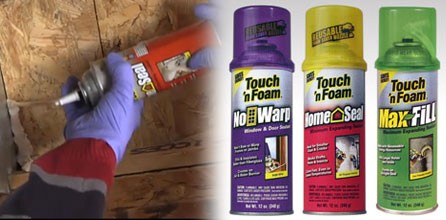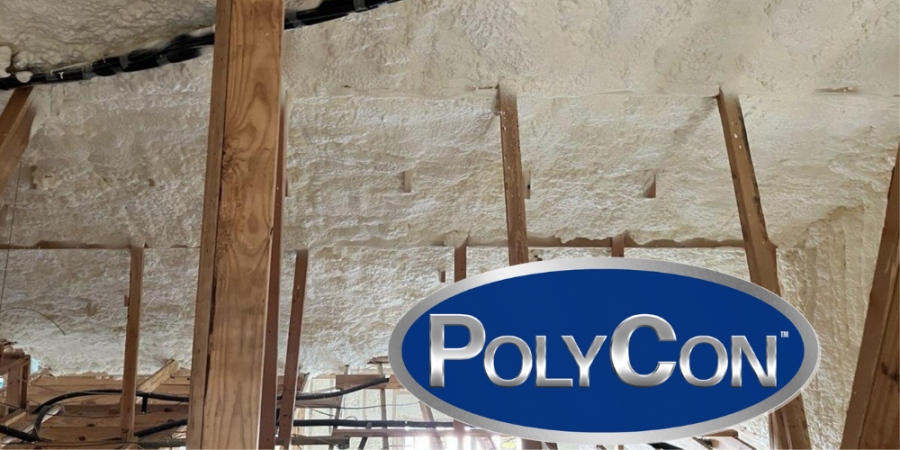Air Seal Your Home for a More Comfortable, Energy Efficient Home

ST. LOUIS, MO — April 18, 2011 — Whether it’s keeping out the winter drafts or guarding against summer heat, most homeowners know the challenge of maintaining a comfortable living environment while watching their budget. Air leaks from drafty windows, gaps and cracks around the house can cause even a well-insulated home’s energy bills to soar. However, air sealing a home with Touch ‘n Foam DIY insulating foam sealants is an easy and inexpensive way for homeowners to improve energy efficiency and home comfort year-round.
The bulk of energy loss in a home comes from dozens of small holes, cracks and gaps inside and outside that allow air leakage. “Sealing air leaks with insulating spray foam sealants is one of the most practical and economical ways to block heat loss in winter and heat gain in summer, ” says Kevin Corcoran, marketing manager at Touch ‘n Foam.
LOCATING HOUSE LEAKS
The first step in air sealing a home begins with locating the leaks. “Some leaks, like those around windows and doors, are easy to identify because a homeowner can usually feel the air escaping or penetrating their home,” says Corcoran. “But be sure to also inspect for less obvious cracks and gaps in and around the home.” He recommends checking indoor places such as heating and dryer vent penetrations, gaping baseboards, and wall cracks along sill plates and floor/wall junctions. Corcoran also suggests inspecting outdoors for leaks a t the bottom of siding edges where they meet the foundation, along garage ceiling and wall joints, and electric, gas and A/C penetrations.
FILLING THE VOIDS
After locating where the air is leaking in and out of your home, the next step is selecting the right insulating foam to fill the voids, which can vary significantly in size. Touch ‘n Foam’s MaxFill Maximum Expanding Foam Sealant is ideal for filling in larger cracks and gaps. This s uper-expanding foam creates an airtight, weather-resistant bond that seals out drafts around gaping baseboards, sill plates, siding edges, plumbing stacks and other big sealant jobs around the house.
MaxFill is formulated with renewable energy resources, which replace the petroleum-based raw materials found in other foam. “This is a great product for any homeowner - particularly for environmentally conscious do-it-yourselfers,” says Corcoran.
Touch ‘n Foam’s HomeSeal Minimum Expanding Sealant is better suited for smaller cracks and gaps around the home, both indoors and outdoors. Because it is formulated as a minimum expanding foam, HomeSeal can seep into the smallest cracks and fissures to seal off airspaces. Use it around exhaust vents, walls, plumbing fixtures, electrical outlet boxes and baseboards – wherever you need to control air leakage to prevent energy loss.
SEALING DRAFTY DOORS
Drafty windows and doors are a common culprit when it comes to soaring energy bills and compromising home comfort. Touch ‘n Foam’s No-Warp Window & Door Foam Sealant provides a quick and easy solution to this age-old problem. No-Warp is a low-pressure foam, specially formulated for use around window and door frames. “No Warp seals and insulates without exerting pressure that can be detrimental to window or door frame stability,” explains Corcoran. “Most foams are inappropriate for use around window and door frames because their excessive pressure can warp frames and jambs, rendering the window or door unusable.”
Touch ‘n Foam products are available nationwide at many home and hardware stores, and retails for about $5 per can. For additional information on how to air seal your home and to find a retailer near you, visit http:// www.touch-n foam.com or call 800-323-7357.
# # #
About Touch ‘n Foam:
Touch ‘n Foam is a division of St. Louis-based Convenience Products, a manufacturer of premium-quality insulating foam sealants, specialty coatings and adhesives for use in home improvement and residential commercial and industrial construction. Touch 'n Foam DIY insulating foam sealants help control airflow in and out of homes by filling gaps and cracks in the home's interior and exterior, which helps maintain a consistent temperature year round while lowering utility bills. For more information, visit http://www.touch-n foam.com or call 800-325-6180.
Disqus website name not provided.









































